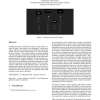Free Online Productivity Tools
i2Speak
i2Symbol
i2OCR
iTex2Img
iWeb2Print
iWeb2Shot
i2Type
iPdf2Split
iPdf2Merge
i2Bopomofo
i2Arabic
i2Style
i2Image
i2PDF
iLatex2Rtf
Sci2ools
SOFTVIS
2006
ACM
2006
ACM
Using social agents to visualize software scenarios
Enabling nonexperts to understand a software system and the scenarios of usage of that system can be challenging. Visually modeling a collection of scenarios as social interactions can provide quicker and more intuitive understanding of the system described by those scenarios. This project combines a scenario language with formal structure and automated tool support (ScenarioML) and an interactive graphical game engine featuring social automomous characters and text-to-speech capabilities. We map scenarios to social interactions by assigning a character to each actor and entity in the scenarios, and animate the interactions among these as social interactions among the corresponding characters. The social interactions can help bring out these important aspects: interactions of multiple agents, pattern and timing of interactions, non-local inconsistencies within and among scenarios, and gaps and missing information in the scenario collection. An exploratory study of this modeling’s ef...
| Added | 14 Jun 2010 |
| Updated | 14 Jun 2010 |
| Type | Conference |
| Year | 2006 |
| Where | SOFTVIS |
| Authors | Thomas A. Alspaugh, Bill Tomlinson, Eric Baumer |
Comments (0)

